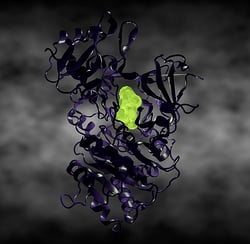 Protein analysis and identification through mass spectrometry first requires a breakdown of each protein into their composite peptides. Once the protein has been broken down, the peptides can be separated through the use of a reverse phase column and the peptides and peptide fragments can be measured using a mass spectrometer.
Protein analysis and identification through mass spectrometry first requires a breakdown of each protein into their composite peptides. Once the protein has been broken down, the peptides can be separated through the use of a reverse phase column and the peptides and peptide fragments can be measured using a mass spectrometer.
Breaking down proteins for analysis is performed through proteases, of which the most commonly used is trypsin. Proteases are designed to be sequence specific and are tailor-made to produce the best protein digestion. Alternative proteases are used for specific sequencing, whereas more versatile all-around proteases may be used throughout the process of mass spectrometry. Ideally, proteases produced for the use of mass spectrometry are able to accommodate multiple strategies for digestion and have been tested for use within mass spectrometry devices. When it comes to proteases, both the digestion time and cleavage specificity are the most important factors. Digestion time may impact the reliability of the mass spectrometry results, while cleavage will impact the separated peptides.
The Distribution, Shipping, and Storage of ProteaseProteases are produced in-solution, in-gel, and isolated as standalone proteases, to be more useful and convenient within a laboratory setting. Pro-teases that are provided in-solution are generally preferred for smaller samples, whereas in-gel suspensions are designed for more complex operations that may require additional control. Either way, the quality of the proteases are still equally validated, and the results of the proteases should be consistent.
The Role of Trypsin in Mass SpectrometryThe protease trypsin has properties that make it uniquely well-suited to mass spec identification, which is why trypsin is the most commonly used protease. Trypsin is able to cleave proteins into the sizes that are ideal for mass spectrometry, between 700 to 1500 Daltons. Additionally, trypsin is active and versatile, able to contain other additives as needed and therefore able to be customized dependent of the sequencing that is being completed. Trypsin performs very limited cleavage at the lysyl-proline and arginyl-proline bonds, while leaving peptide bonds at the carboxyl side of arginine and lysine residues. Essentially, trypsin is able to best digest proteins for the purposes of peptide fragment analysis and sequence analysis. This makes it the fastest and easiest way to get reliable results.
Trypsin's Usefulness in a Laboratory SettingFor use in mass spectrometry, trypsin is tested for quality and methylated for improved stability within a laboratory environment. Trypsin is highly resistant to both degradation and autolysis and it remains shelf-stable and standard temperatures. On a practical level, trypsin is valuable for laboratories because of this high stability; it does not require additional care for either shipping and storage. Both porcine and bovine originated trypsin can be used equally well for the purposes of mass spectrometry, though porcine trypsin tends to be most common. Trypsin is generally supplied in specific volumes within a re-suspension buffer. It's recommended that protein ratios between 1:20 and 1:100 be used for trypsin during the process of mass spectrometry.
When performing mass spectrometry, it's always vital to have the best supplies available. Mass spectrometry can fail if a protease is not stabilized or if the protein is otherwise not fully digested. For the purposes of mass spectrometry, trypsin is refined, stabilized, and tested to ensure that it will provide reliable and accurate results when used for mass spec identification. Though there are other proteases that can be used during mass spectrometry, trypsin provides the best and most reliable readings.
Image source: ynse






